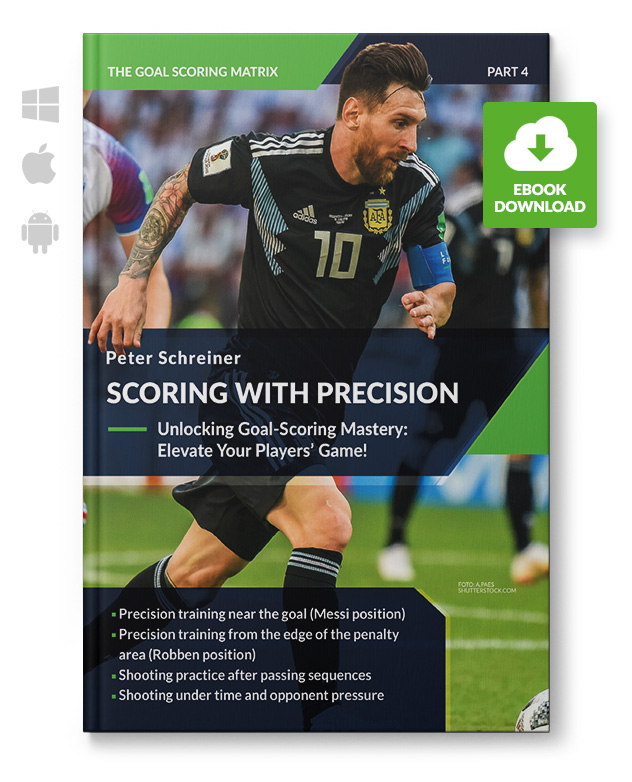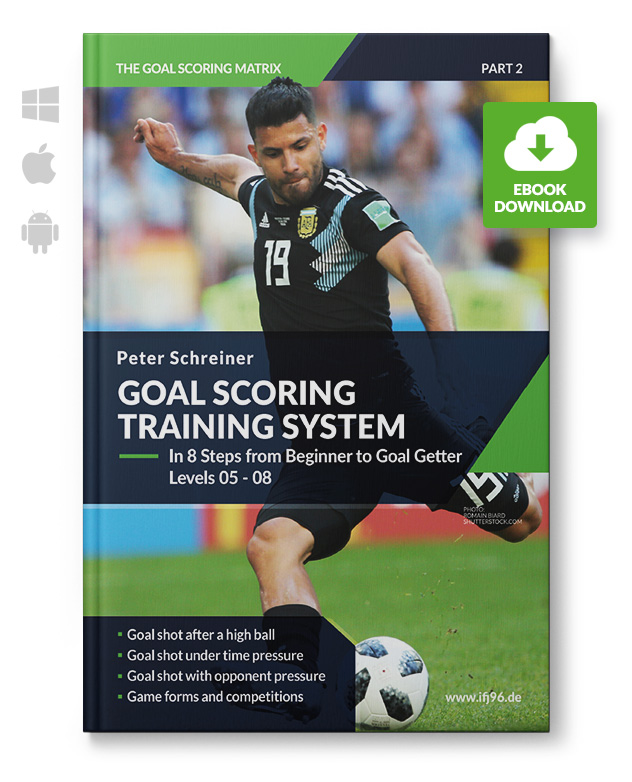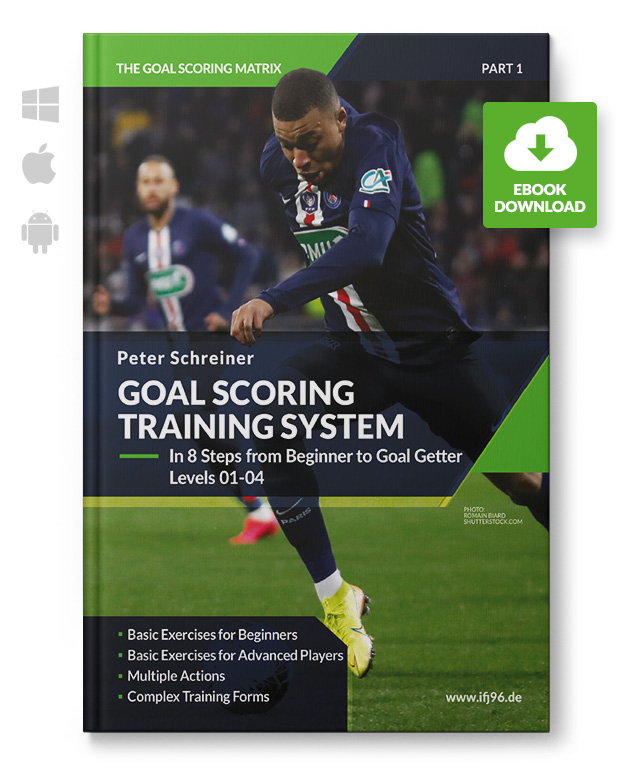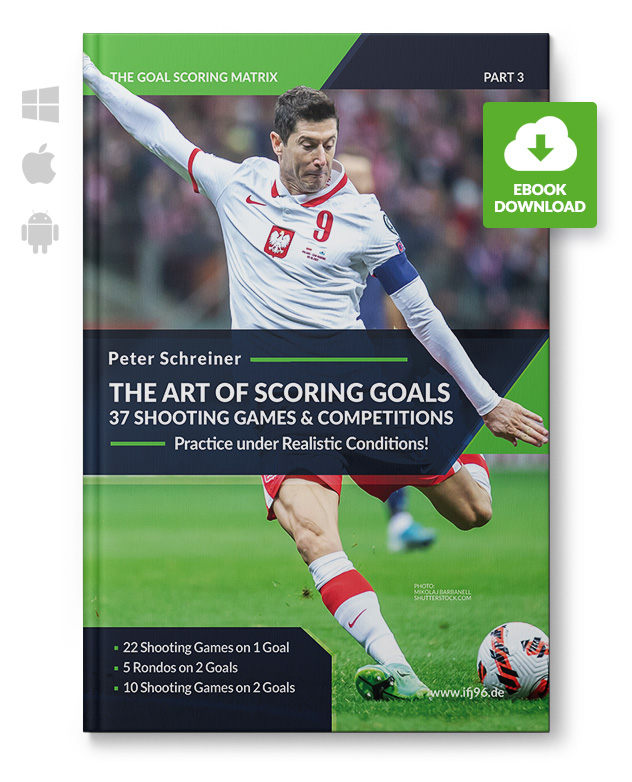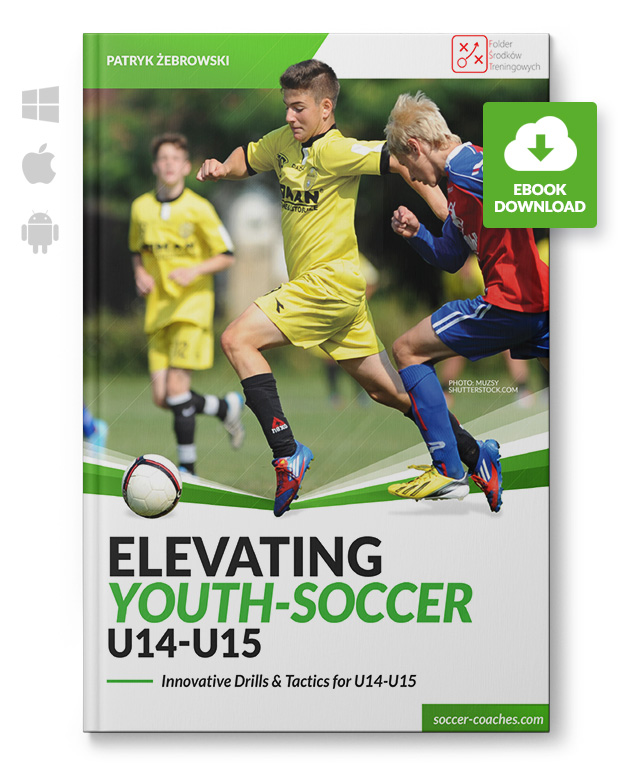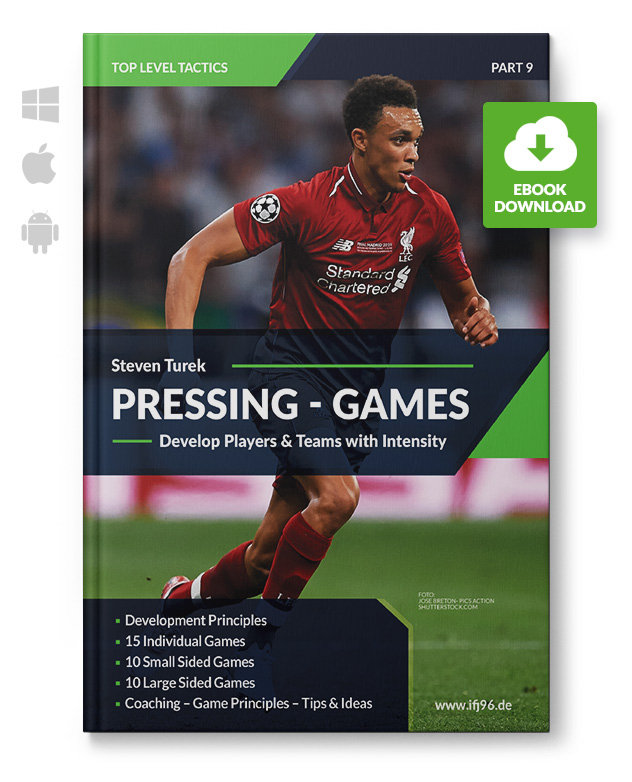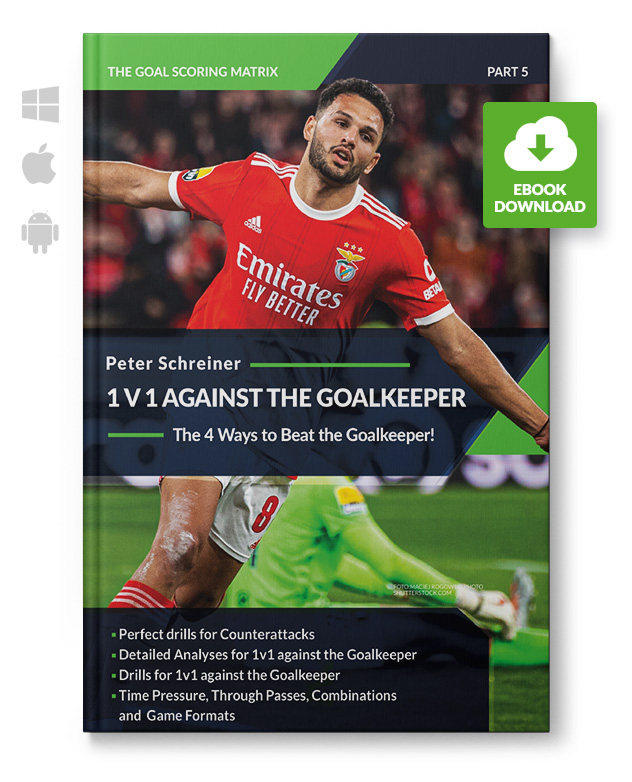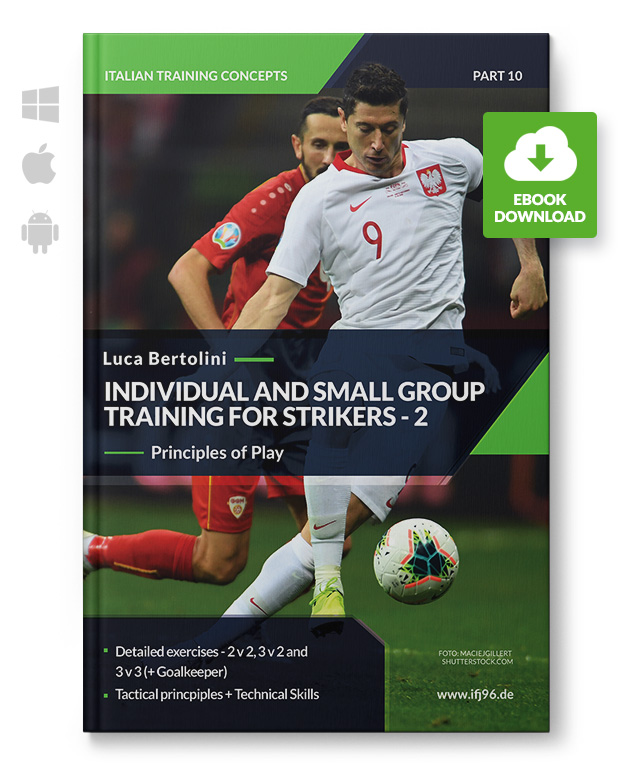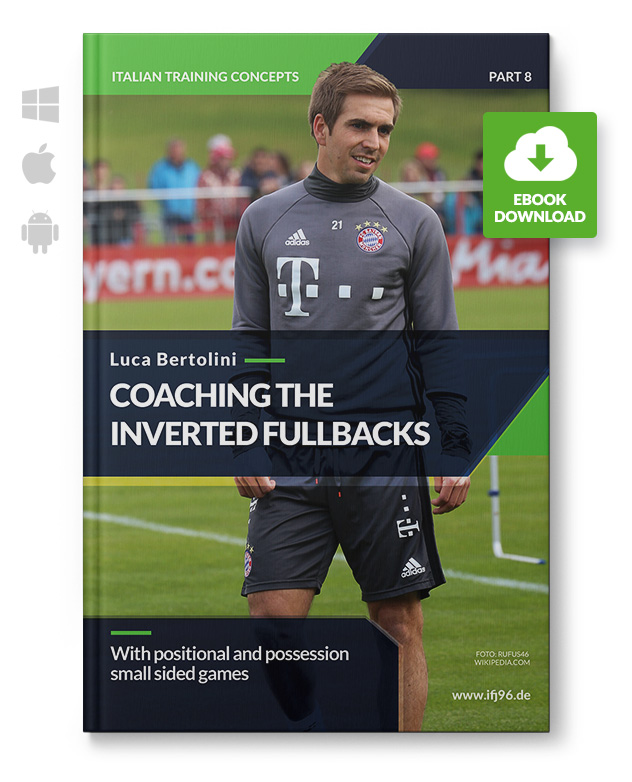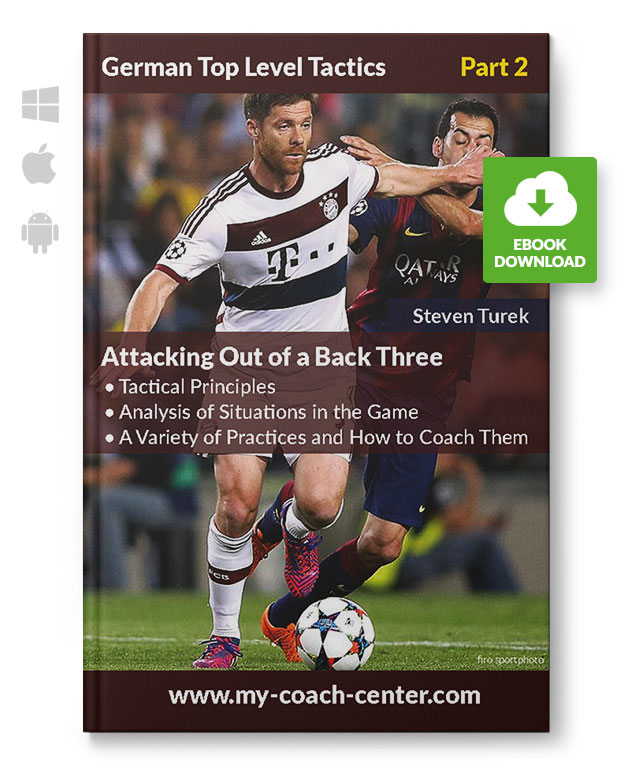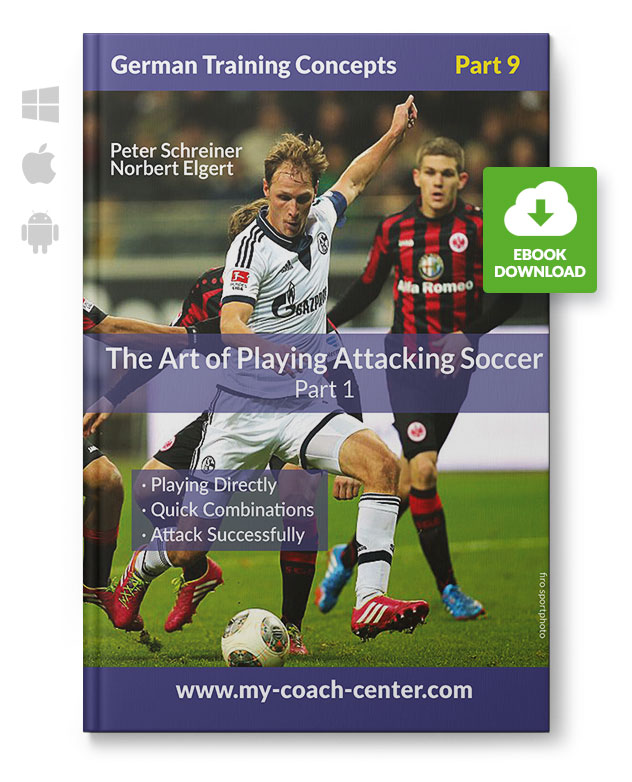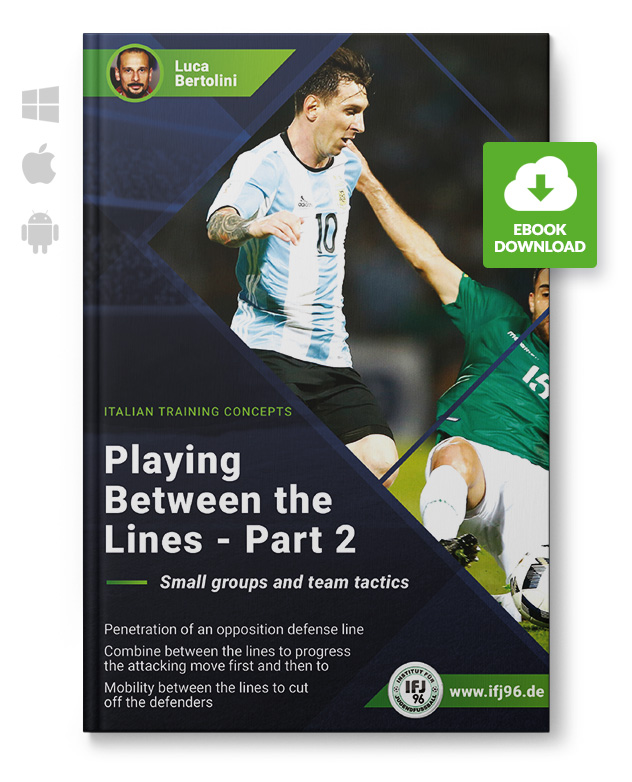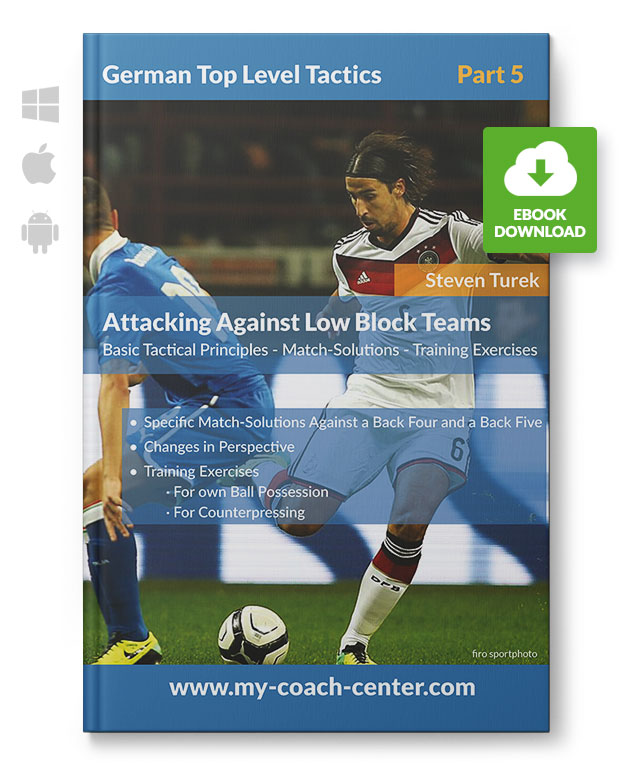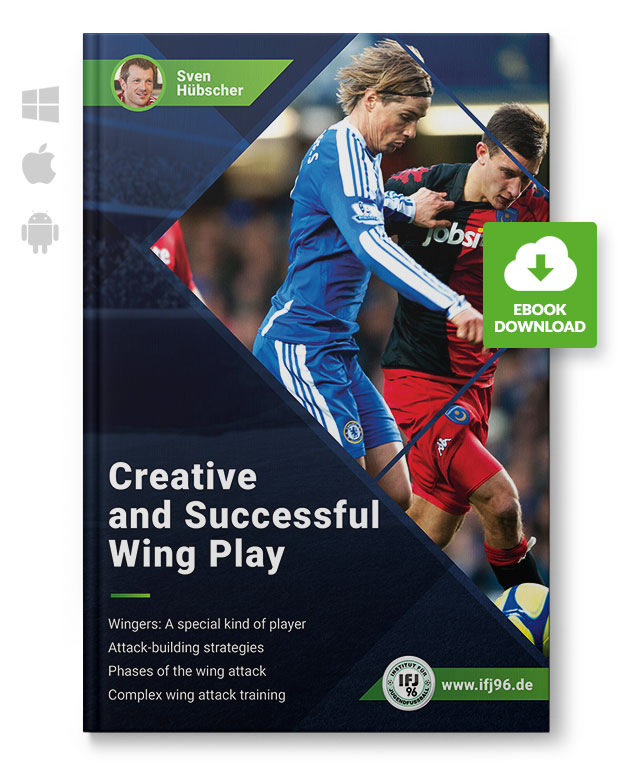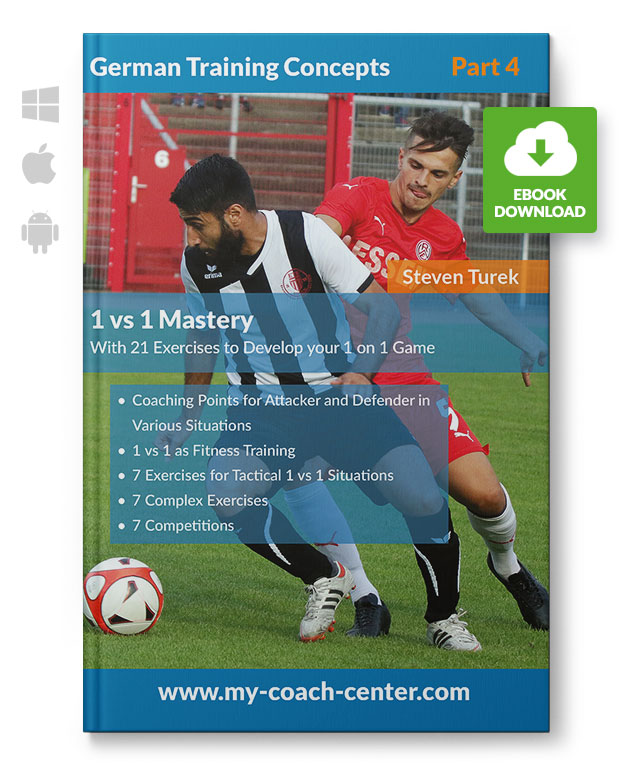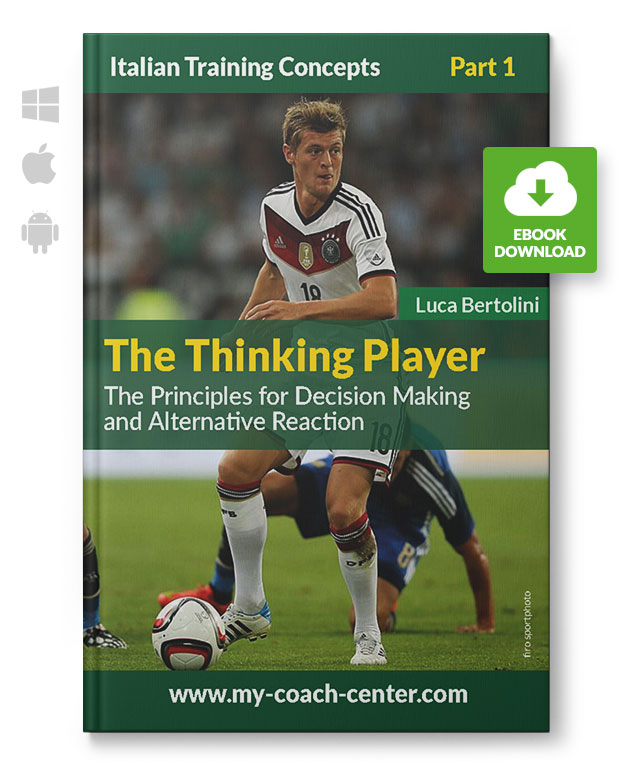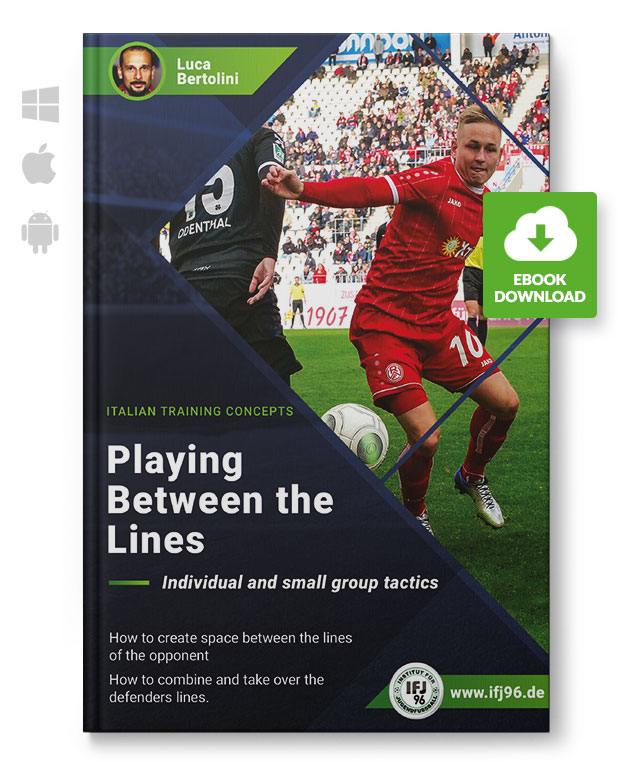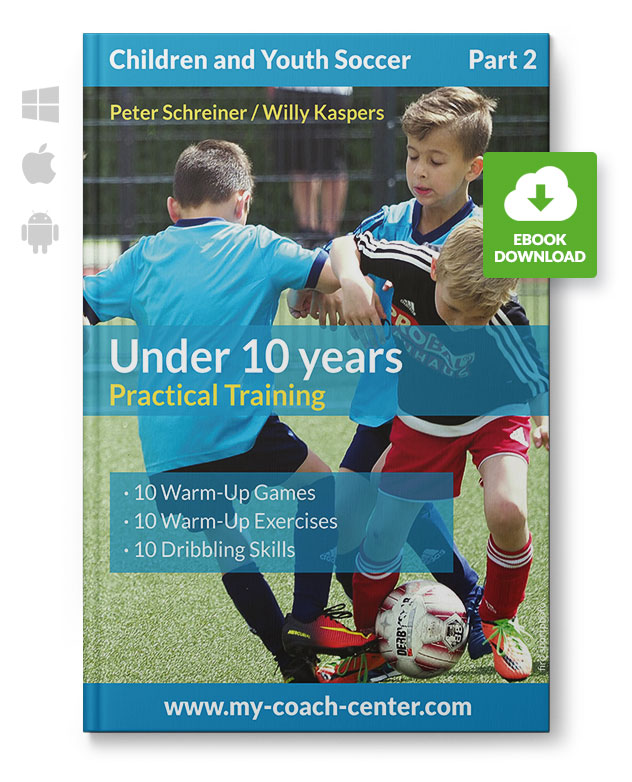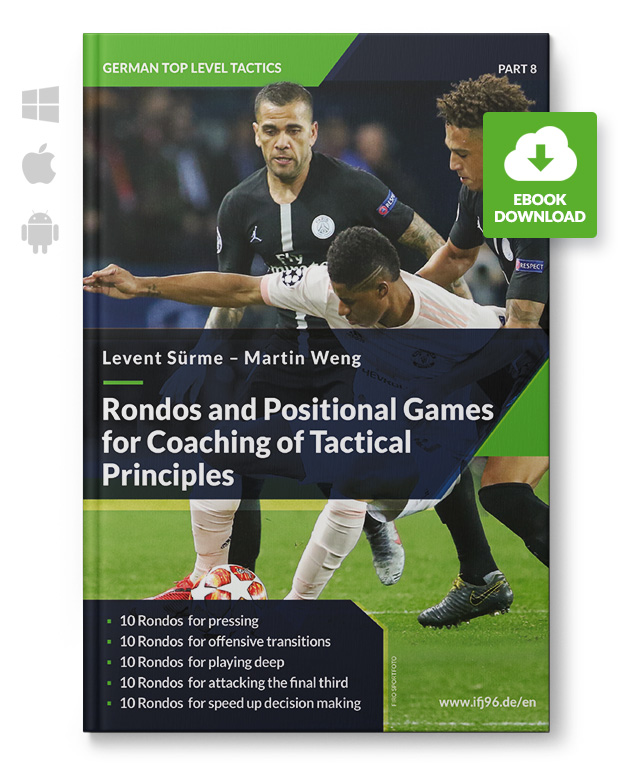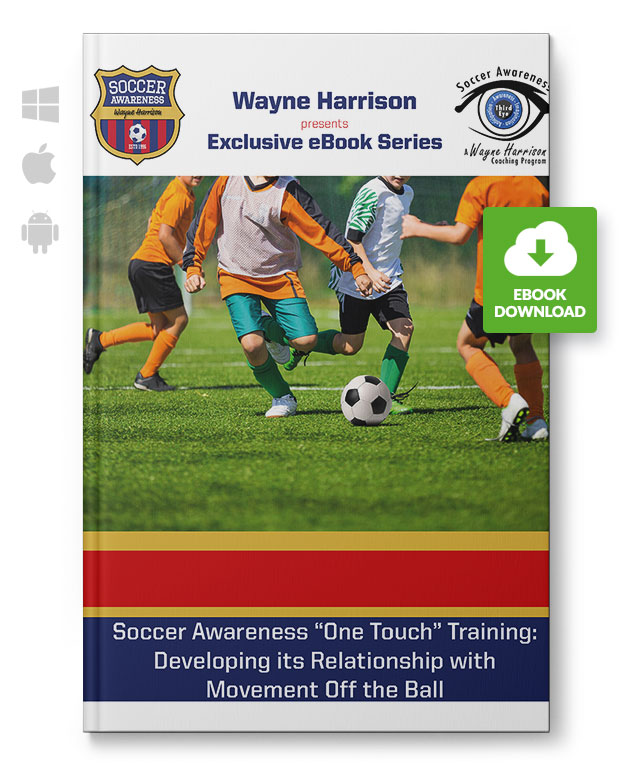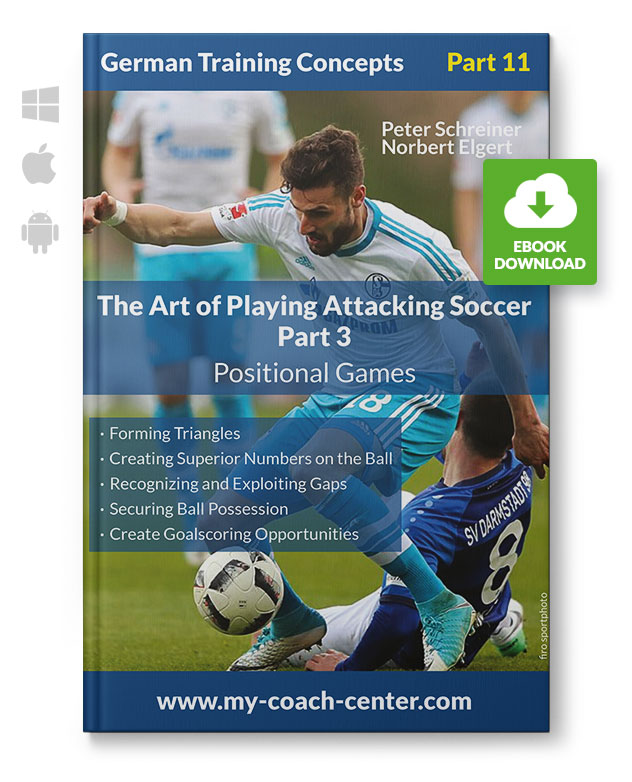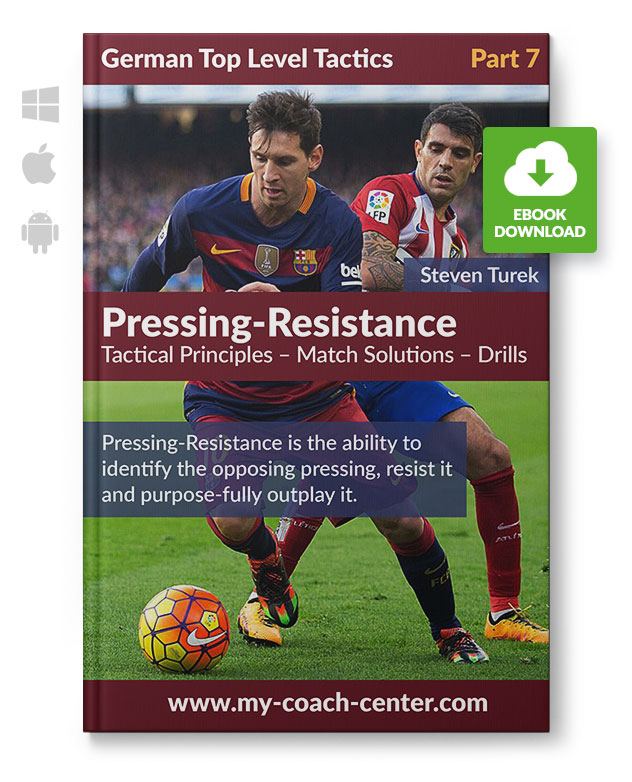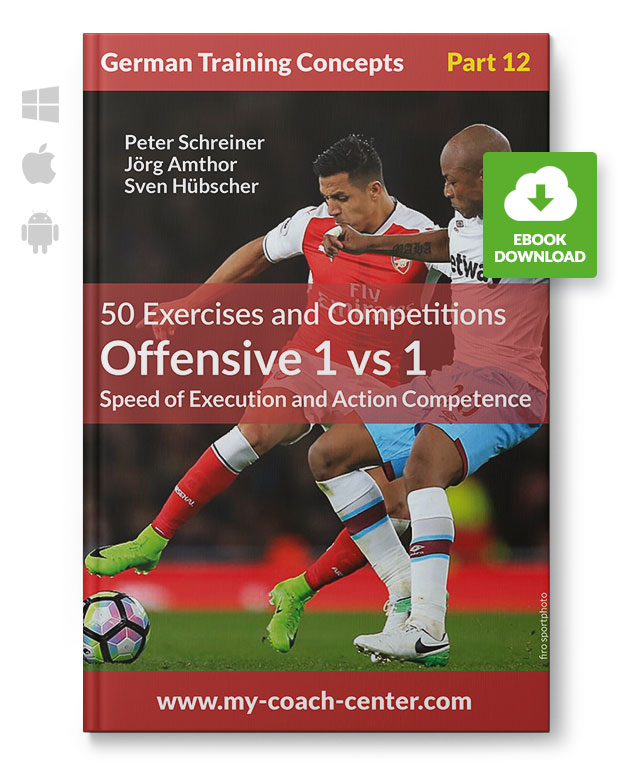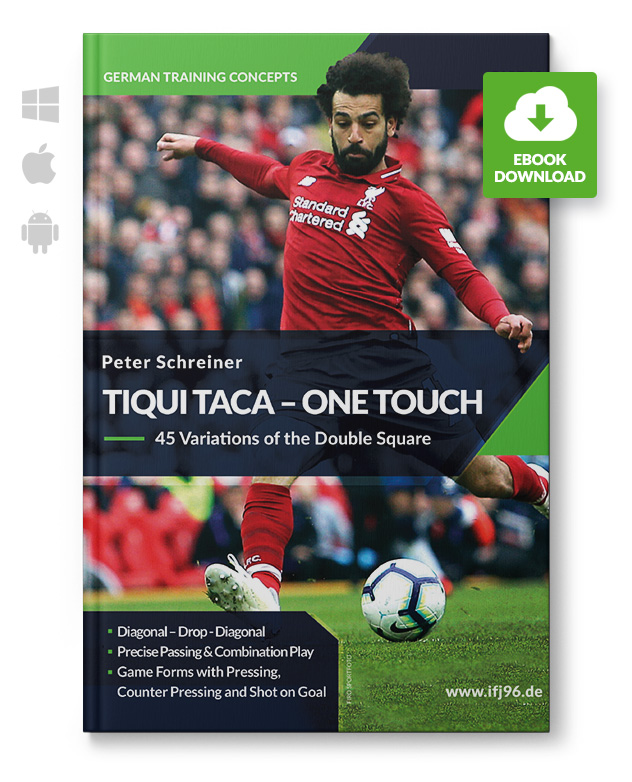eBook Sets - Buy 3 & pay 2
Save up to 40% with our IFJ96 eBookbundles. How does it work? Simply add 3 IFJ96 eBooks to your shopping cart and the cheapest eBook will be credited to your order for free.
By the way, this promotion also applies to booklets - you can find them here!
Set of 3 eBooks
%
New
Author: Peter Schreiner Pages: 106 Practices: 64 Level: U11-PRO PDF Preview of "Scoring with Precision" In the 4th part of the series: "The Goal Scoring Matrix," the focus is on the precision of goal scoring, which is necessary to consistently and regularly make the most of scoring opportunities. World renowed coaches instructor Peter Schreiner shows you how to immprove the precision of your players, in theory and practice, including valuable coaching points and 64 practices! The Art of Accuracy: Advanced Techniques in Goal Scoring Precision is not improved by constantly repeating the same motion (grooving) but through "differential learning." This eBook explains what makes this training special and how it truly enhances players' precision in goal scoring. It also pays special attention to players' ability to use both feet, which is extremely important for goal scorers. Is it possible to train goal scorers through targeted goal scoring training? What qualities does a goal scorer have who consistently scores over a long period? The "Goal Scoring Matrix" provides important insights on this. In this 4th part, the focus is on a very important component, namely the precision of goal scoring, with the following key areas: Precision training close to the goal (Messi position) Precision training from the edge of the penalty area (Robben position) The Goal Scorer's Diamond The Haaland Triangle - Perfect movement to get open for goal scoring Goal scoring after passing sequences – preparing for shots Goal scoring under time pressure and opponent pressure Peter Schreiner teaching and presenting the Goal Scoring Matrix worldwide Peter SchreinerThe former coach and youth soccer expert, including U19 Schalke 04 and former leader of the Schalke 04 youth academy, is the founder of the Institute for Youth Soccer and a sought-after coach educator, author, and speaker with numerous appearances at soccer congresses (DFB, BDFL, AEFCA) in over 28 countries. His publications have been translated into more than 7 languages.Many of his publications, which he released with well-known co-authors including Horst Wein and Norbert Elgert, are considered standard works today. These include "The Art of Offensive Soccer" and "Developing Game Intelligence".He is the organizer of the "Debystar Youth and Amateur Coaches Congress" and co-founder of "easy Sports-Software".
€13.95* €14.95* (6.69% saved)
%
Author: Peter Schreiner Pages: 92 Pages Practices: 47 Level: U11-PRO PDF Preview of "Goal Scoring Training System - Levels 05-08" For years, Peter Schreiner has been engaged in the topic of "shooting training in soccer." In the training of young players, targeted shooting training is often neglected. Yet, players love training forms with a focus on shooting. In his new series of booklets/eBooks, Peter Schreiner shows his systematic shooting training in 8 learning levels. With targeted detail coaching, players are helped to avoid mistakes and to perfect their behavior when shooting. This avoids shooting the ball at the goal in any old way during training and – what is even more regrettable – in competition. Players learn to successfully put the ball into the net in a variety of situations. Schreiner He has analyzed over 1500 goals of top goal scorers in Europe and developed a training concept. This was followed by lectures worldwide, including for the AEFCA and the BDFL, as well as practical presentations in seminars and at conferences. Goal Scoring Training System - Part 2 The systematic development of a goal scorer takes place in eight successive learning levels, starting at age 7 and bearing fruit in the high-performance area. In this eBook/booklet, the difficulty level is increased. Level 5 introduces shooting exercises under more challenging conditions. The pass before the shot is no longer always flat but comes as a lobbed ball. In levels 6 and 7, time pressure and opponent pressure before or during the shot are central. And in the final training level, it becomes very game-like. In learning level 8, it's about game forms where the shot is required under competition conditions. Learning Level 5: Difficult Conditions - Shooting after a Lobbed Ball Players convert balls thrown at them with foot or head. They shoot at the goal under difficult conditions (after a cross, shooting after turning, a sprint, or in a jump). Learning Level 6: Shooting under Time Pressure Players apply different shooting techniques in shooting exercises or group competitions under time pressure. Learning Level 7: Shooting with Opponent Pressure Offensive 1 vs 1: Players shoot at the goal after a duel or an attack by an opponent. Learning Level 8: Game Forms/Competitions In game forms with numerical advantage (neutral players) and equal numbers, create and convert scoring opportunities under the greatest opponent pressure. Shooting in competitive situations (competitions in the double penalty area/on a reduced field with 2 goals). About the Author Peter SchreinerThe former coach and youth soccer expert, including U19 Schalke 04 and former leader of the Schalke 04 youth academy, is the founder of the Institute for Youth Soccer and a sought-after coach educator, author, and speaker with numerous appearances at soccer congresses (DFB, BDFL, AEFCA) in over 28 countries. His publications have been translated into more than 7 languages.Many of his publications, which he released with well-known co-authors including Horst Wein and Norbert Elgert, are considered standard works today. These include "The Art of Offensive Soccer" and "Developing Game Intelligence".He is the organizer of the "Debystar Youth and Amateur Coaches Congress" and co-founder of "easy Sports-Software".
€13.95* €14.95* (6.69% saved)
%
Author: Peter Schreiner Pages: 78 Pages Drills: 38 Practices Level: U11-PRO PDF Preview of "Goal Scoring Training System - Levels 01-04" Goal-Scoring Mastery: Techniques for Developing Soccer Strikers Introducing the "Goal Scoring Training System" by Peter Schreiner. 78 pages packed with insights and strategies, this book offers a structured approach to developing shooting skills from beginner to elite levels.Featuring 38 practices, readers will discover practical exercises for honing shooting technique, along with invaluable tips for effective coaching. Whether you're a seasoned coach seeking new ideas or just want to improve the scoring prowess of your players, this book is your ultimate resource for mastering the art of scoring goals in soccer. For years, Peter Schreiner has been focusing on the topic of to develop and coach goal getters successfully. In the training of young players, targeted shooting training is often neglected. However, players love training sessions focused on shooting. Peter Schreiner - Working with Strikers Systematic Approach in 8 Learning Levels In his new series, Peter Schreiner presents his systematic shooting training in 8 learning levels. With targeted detail coaching, players are helped to avoid mistakes and perfect their behavior when shooting. This prevents the ball from being shot at the goal in training and – even more regrettably – in competition, in any old way. Players learn to successfully score goals in various situations. For his training, Schreiner has extensively studied "Shooting Training" and "Individual Training for Strikers". He analyzed over 1500 goals from Europe's top scorers and developed a training concept. This was followed by worldwide lectures, including for the AEFCA and the BDFL, as well as practical presentations in seminars and at congresses. Goal Scoring Training System - Part 1 The systematic development of a goal-getter takes place in eight consecutive learning levels, starting at 7 years old and bearing fruit in the high-performance sector. This booklet covers the first 4 learning levels, laying the foundation for further training and providing basic exercises for beginners and advanced players, multiple actions (shooting), and complex training formats. Level 1: Basic Exercises for Beginners Players shoot a stationary ball directly at the goal. Players shoot a rolling ball directly at the goal. Players shoot the ball into the goal after controlling a flat pass. Level 2: Basic Exercises for Advanced Players Players shoot the ball directly into the goal from various directions after a flat pass. Level 3: Multiple Actions (Shooting) Players apply shooting techniques repeatedly, variably, and situationally, adjusting to changing speeds and directions of the ball. Level 4: Complex Training Formats Shooting after passing sequences Players shoot at the goal in a complex training format with group tactical elements (one-two pass, play over the third player, overlap, "through-pass and return", etc.) while in motion. Goal Scoring in Theory and Practice In the theoretical part, Peter Schreiner lays the groundwork for successful shooting training. Questions like "What characterizes effective shooting technique training?" or "What goals does the coach pursue in systematic shooting training?" are answered in detail. Each exercise is thoroughly illustrated and described, including important coaching points to improve the players. Peter Schreiner teaching and presenting the Goal Scoring Matrix worldwide Mastering Goal-Scoring Techniques in Modern Soccer "The Art of Scoring Goals" offers an essential distinction between various practice formats, contrasting controlled exercises without opponents with complex shooting games that demand quick thinking and precision amidst adversaries. This approach not only provides a comprehensive understanding of shooting techniques but also serves as a transformative tool for forwards and attacking players. Guiding them on a journey to becoming skilled and confident goal-scorers, this eBook is invaluable for those preparing for the rigors of modern football. It's a critical resource for both coaches and players, paving the way for unlocking scoring potential and achieving on-field success. About the Author Peter SchreinerThe former coach and youth soccer expert, including U19 Schalke 04 and former leader of the Schalke 04 youth academy, is the founder of the Institute for Youth Soccer and a sought-after coach educator, author, and speaker with numerous appearances at soccer congresses (DFB, BDFL, AEFCA) in over 28 countries. His publications have been translated into more than 7 languages.Many of his publications, which he released with well-known co-authors including Horst Wein and Norbert Elgert, are considered standard works today. These include "The Art of Offensive Soccer" and "Developing Game Intelligence".He is the organizer of the "Debystar Youth and Amateur Coaches Congress" and co-founder of "easy Sports-Software".
€13.95* €14.95* (6.69% saved)
%
Author: Peter Schreiner Pages:77 Pages Drills: 37 Practices Level: U11-PRO PDF Preview of "The Art of Scoring Goals" Precision Under Pressure: 37 Drills for Shooting Skills This eBook by Peter Schreiner, offers a rich collection of 37 detailed drills, emphasizing the development of shooting techniques effective under the intense pressure of real-game situations. Each practice is made to simulate match-like conditions. The focus is on improving technical prowess in one-touch finishes and first-touch ball control, crucial within the penalty area where most goals are scored. Various game formats, from drills focusing on one main goal to dynamic competitions involving two goals. Schreiner emphasizes the importance of varied and adaptable shooting training, teaching players to quickly respond to changing game situations and make swift decisions. Peter Schreiner teaching and presenting the Goal Scoring Matrix worldwide Mastering Goal-Scoring Techniques in Modern Soccer "The Art of Scoring Goals" offers an essential distinction between various practice formats, contrasting controlled exercises without opponents with complex shooting games that demand quick thinking and precision amidst adversaries. This approach not only provides a comprehensive understanding of shooting techniques but also serves as a transformative tool for forwards and attacking players. Guiding them on a journey to becoming skilled and confident goal-scorers, this eBook is invaluable for those preparing for the rigors of modern football. It's a critical resource for both coaches and players, paving the way for unlocking scoring potential and achieving on-field success. About the Author Peter SchreinerThe former coach and youth soccer expert, including U19 Schalke 04 and former leader of the Schalke 04 youth academy, is the founder of the Institute for Youth Soccer and a sought-after coach educator, author, and speaker with numerous appearances at soccer congresses (DFB, BDFL, AEFCA) in over 28 countries. His publications have been translated into more than 7 languages.Many of his publications, which he released with well-known co-authors including Horst Wein and Norbert Elgert, are considered standard works today. These include "The Art of Offensive Soccer" and "Developing Game Intelligence".He is the organizer of the "Debystar Youth and Amateur Coaches Congress" and co-founder of "easy Sports-Software".
€13.95* €14.95* (6.69% saved)
%
PDF Preview of "Elevating Youth-Soccer U14-U15" Authors: Konspekty Piłka Nożna (Patryk Zebrowski) Pages: 102 Graphics: 129 Conspects: 20 This book is your essential guide to mastering the challenges and opportunities in training U14-U15 players as they transition into the 11x11 format of the game. At this crucial age, players not only step into a more demanding level of soccer but also navigate through significant physical and psychological changes. Our mission is to equip you with the knowledge and tools to guide these young athletes through this transformative phase with confidence and effectiveness. Individual Player Development & Team Dynamics Packed with 20 comprehensive training outlines, each meticulously designed with clear objectives, detailed exercise descriptions, and helpful graphics, this book is a treasure trove for coaches seeking to elevate their training sessions. From individual player development to team dynamics, and from enhancing physical abilities to fostering mental growth, every aspect of coaching young footballers is covered. Discover strategies for effective communication, both verbal and non-verbal, learn to create a positive and impactful game environment, and understand the nuances of formative training. This book also delves into the specifics of motor and coordination skills, strength, flexibility, and endurance tailored for the youth player. TABLE OF CONTENTSINTRODUCTIONTHE NEXT STAGE OF DEVELOPMENTFIRST STEPS OF THE COACH IN THE CATEGORY OF TRAMP PLAYERSINDIVIDUAL APPROACH TO THE PLAYERSGAME MODELAPOSITIONING AND FUNCTIONING DURING THE GAME MORE IS NOT BETTERVERBAL/NON-VERBAL COMMUNICATIONCAMP - WORKING FROM THE POINT OF VIEW OF THE CONTENTCAMP - IN PRACTICAL TERMSFORMATIVE TRAININGSTRICT FORMSMALL GAMES - IMPORTANCE IN THE TRAINING PROCESSINFLUENCE OF THE COACH ON THE GAME ENVIRONMENTFORMATION OF MOTOR ABILITIESCOORDINATION ABILITIESPOWERFLEXIBILITYDURABILITYYOUTH FOOTBALL PLAYERPERCEPTUAL PROCESS TRAININGPLAN - IMPLEMENTATIONCOMPETING IN YOUR OWN BACKYARDEMPATHYAUTHORCONSPECT 1 - Perfecting the defensive game in small gamesCONSPECT 2 - Organising the defensive gameCONSPECT 3 - Organising the defensive gameCONSPECT 4 - Group action in balance in the attack phaseCONSPECT 5 - Perfecting the opening of the game from the goalkeeperCONSPECT 6 - Organisation of the game after receiving the ballCONSPECT 7 - Games to improve holding on to the ball CONSPECT 8 - Improving 1x1 attacking skillsCONSPECT 9 - Opening up and building up the gameCONSPECT 10 - Games to improve holding on to the ballCONSPECT 11 - Building up play in the opposition's halfCONSPECT 12 - Small games for the transition phaseCONSPECT 13 - Perfecting the attacking phaseCONSPECT 14 - Finalisation of the game using a player from the "9" position with his back to the goalCONSPECT 15 - Building the game with emphasis on finalization by attacking the free spaceCONSPECT 16 - Opening and Building the GameCONSPECT 17 - Small games with emphasis on the transition phaseCONSPECT 18 - Opening and building up the gameCONSPECT 19 - Opening and building up the gameCONSPECT 20 - Perfecting the pass one line further Konspekty Piłka Nożna Konspekty Piłka Nożna is a young team consisting of two coaches (Patryk Klimczak and Marek Bączyk) who transformed their passion and career path into an idea for a business. They already have several excellent publications, which have been noticed by children's football coaches from all over Poland, they can also boast of cooperation with the giant which is the Asystent Trenera.
€13.95* €14.95* (6.69% saved)
%
Author: Steven Turek Pages: 64 Pages Drills: 35 Practices Level: U11-PRO PDF Preview of "Pressing - Games" Pressing Mastery: Practices, Insights, Tips and Tricks by Steven Turek "Pressing Games" is a practical eBook for soccer coaches, written by Coach Steven Turek. It offers 35 effective drills focused on pressing and counter-pressing, inspired by successful teams like FC Barcelona, FC Liverpool, and those coached by Mourinho and Simeone. This book provides straightforward coaching tips and game principles, aiming to enhance players' skills in high-intensity play. It's a valuable resource for coaches looking to improve their team's performance in pressing, with accessible, impactful training methods that will elevate your team's game. Steven Turek during a coaching seminar Defensive Dynamics: Mastering Opponent Possession The book focuses on the "Opponent Possession" phase in soccer, emphasizing defensive strategies when the opponent controls the ball. It outlines key principles of play, serving as a practical framework for training and communication between coaches and players. The guide features game forms, from 1v1 to 11v11, structured around these principles to simulate real-match scenarios. Key defensive tactics covered Applying Pressure Building and Defending Lines Altering Lines Recovering Lines Man Marking/Block Preparing Counters These principles are essential for a team's defensive strategy, adapting to the game's dynamics. The book also offers coaching tips for anticipating plays and positioning players for effective defense and quick offensive transitions. About the Author Steven TurekBorn in 1990, Steven is a coach in professional youth football. Since 2016, he has contributed to dozens of coaching resources (books, eVideos, and more), published in numerous international coaching magazines, and is a sought-after speaker both domestically and abroad. Since 2019, he has been a co-founder of the coaching platform Coach2 – Academy, which offers online courses for coaches.
€13.95* €14.95* (6.69% saved)
%
PDF Preview of "1v1 against the Goalkeeper" AuthorPeter Schreiner Pages98 Pages Drills37 Practices LevelU11-PRO Dive into the exhilarating world of soccer with Peter Schreiner's insightful eBook, "1v1 Against the Goalkeeper". Spanning 96 pages, this detailed guide is tailored for players and coaches keen on mastering the critical aspects of soccer – counterattacks and one-on-one confrontations with goalkeepers. Counterattacks & 1v1 against the Goalkeeper This eBook is structured into two focused sections. The first part delves into counterattacks, providing a comprehensive look at situations leading to 1v1 against the goalkeeper. Schreiner presents a range of training scenarios, from 1 against 0 to 3 against 2, emphasizing time pressure and tactical decision-making. The second part zeroes in on the climactic 1v1 standoff with the goalkeeper, outlining four strategic methods to gain the upper hand. Now available as en eBook - 1v1 Against the Goalkeeper Peter Schreiner doesn't just focus on the physical aspect; he delves into the immense psychological pressure strikers face and the tactical wisdom needed to score under these high-stakes conditions. The book places a strong emphasis on understanding the goalkeeper's behavior to inform the striker's actions. With 37 detailed drills, complete with coaching points, this book offers a hands-on approach to training. These exercises are designed to sharpen decision-making skills and execution in crucial game moments. Additionally, the eBook provides deep analyses of game scenes, identifying common mistakes strikers make and offering strategies to rectify them. Highlights of the book include: Comprehensive strategies for mastering counterattacks in soccer. Tactical insights into overcoming the goalkeeper in various scenarios. 37 detailed training drills with specific coaching points for practical learning. Analytical breakdowns of game scenes to identify and fix strikers' mistakes. Essential skills development for both individual players and teams. "1vs1 Against the Goalkeeper" is an essential read for anyone in the soccer world looking to elevate their attacking skills. It's a fusion of tactical knowledge and practical training, making it an indispensable tool for coaches and players alike. Transform your approach to the game with the expertise of Peter Schreiner, and become a master of the goal-scoring craft in soccer! Peter Schreiner teaching and presenting the Goal Scoring Matrix worldwide About the Author Peter SchreinerThe former coach and youth soccer expert, including U19 Schalke 04 and former leader of the Schalke 04 youth academy, is the founder of the Institute for Youth Soccer and a sought-after coach educator, author, and speaker with numerous appearances at soccer congresses (DFB, BDFL, AEFCA) in over 28 countries. His publications have been translated into more than 7 languages.Many of his publications, which he released with well-known co-authors including Horst Wein and Norbert Elgert, are considered standard works today. These include "The Art of Offensive Soccer" and "Developing Game Intelligence".He is the organizer of the "Debystar Youth and Amateur Coaches Congress" and co-founder of "easy Sports-Software".
€13.95* €14.95* (6.69% saved)
%
PDF Preview of "Scanning, Movement off the Ball Behavior and Teaching One-Touch Thinking" Author: Wayne Harrison Publisher: Institute for Youth Football, (IFJ96) Production: Peter Schreiner, Jörg Amthor Pages: 147 Graphics: 93 In this eBook Wayne Harrison explains the basic principles of developing the One Touch game and presents his training of first and second contact and the development of two-footedness. Players are often very good at playing with lots of contact with the ball, i.e. dribbling, turns and running with the ball, i.e., training and playing in a more technically oriented play. Unfortunately, far too often our talents are not as good at quick thinking processes and quick decision making, especially when playing with one contact. That's exactly what this e-book aims to teach! The practice and game forms always have one goal: To develop composure in possession of the ball, to reduce the time and number of ball contact and the number of ball contacts needed to keep the ball in motion. In addition, by becoming more aware of everything around him, the player in possession of the ball can use his imagination to make better decisions. Which applies to the same extent to the players without the ball. The point is definitely not to have the players play at a high speed, and always one-touch, but to teach them to be aware of all the possibilities (with correct foot position and body posture) even before a pass is made, in order to make one of the following decisions: Should I play the ball with one contact? Should I hold onto the ball until another option opens up? Is this the time to run with the ball, dribble, pass, cross or shoot? This training will enable the player on the ball to quickly control it with one or two contacts. In doing so, he will recognize his options so that no third or fourth contact is needed to see where the opponents are, so that he also does not need so that he does not need any additional contacts to get out of the way successfully. We train their bodies for footwork and their minds for decision making! Content: One touch awareness development training Number passing games Basics of awareness coaching methodology Methodical training Use of dummies The false nine Three-zone game shape for improvement of the Scanning; Movement OFF the ball Behavior Awareness development Targeted switching game with 16 players Improving of the targeted passing game in three-zone mode Opponents Introduction Directional game forms Awareness game form with three teams About the author
€13.95* €14.95* (6.69% saved)
%
PDF Preview of "Build-Up and score goals with the 3rd man" Author: Athanasios Terzis Publisher: Institute for Youth-Soccer (IFJ96) Pages: 107 Graphics: 79 Drills: 12 The tactics about the 3rd man and the 3rd man’s run which is analyzed in this book, is part of the tactics used by Jurgen Klopp with Liverpool, Julian Nagelsmann with Bayern Munich, Marcelo Bielsa with Leeds United, Pep Guardiola with Manchester City and Luciano Spalletti with Napoli. Specifically, the 3rd man combination is an important element of positional play, in which three attacking players are involved. The objective is to create a free player with available space in advanced position, behind the line of pressure and then move the ball to him. So, when it is applied successfully it can lead in breaking at least one line of pressure. Diagram: 3rd man combination during the execution phase – Moving the ball to the free player The 3rd man combination can be used in several match situations such as when building up from the back in order to break through the pressure applied straight to the GK or to the central defenders. It can also be used against a medium or a low defensive block to help the attacking team break a line of pressure and move the ball to a free player between the lines. Diagram: Breaking through the pressure applied to the GK Except for the 3rd man combination, the book analyses the patterns of the 3rd man’s run that are most frequently used during matches, either in the central areas or wide. The 3rd man’s run, like the 3rd man is also a combination which involves three players. The objective is not to create a free player and move the ball to him, but to move the ball to an attacking player who is on the run, usually behind the defensive line of the opponents. Diagram: 3rd man’s run – 2nd pattern So, if the application of the combination is successful, a goal scoring opportunity can be created. The book will present the most frequently used patterns and the match situations that each specific pattern can be used, as well as how each pattern can be adapted to various formations. Diagram: Pattern 2 of the 3rd man’s run –Applied with the 1-4-2-3-1 formation The analysis of the two combinations (3rd man and 3rd man’s run) is followed by several drills to help coaches apply the analyzed tactics to their teams, by simply adding or adjusting them to their own training sessions.
€13.95* €14.95* (6.69% saved)
%
Author: Luca Bertolini Pages: 72 Illustrations and Figures: 102 If we think about all the systems of play, there are many types of defense tactics; the first big difference can be found among the defense lines with three, four or five players. But these following can be considered deeper differences: How to play during negative transitions How and when to put pressure How and when run back to cover the spaces How and when to try to recover the ball How and when play with counterpressing How and when mark an opponent and when to cover the back spaces to him Who is the first defender among the forwards in the final or in the middle third Who is the defending midfielder or when to follow the opponents or when to try to close him. Or, why not, who is the defender who manage the whole defensive line. But there are common principles of play of defense which every player should know as basic skills. These are the individual tactics principles of defense against one an opponent. These skills should be learned by all players as they are so independent from the systems of play. In this book there is a progression of exercises which starts from some simple sequences, which will lead up to a final exercise where all the principles of play are mixed during its development. All exercises are combined with little goals to save and use as reference point. The final exercises include a regular goal and a goalkeeper who takes active part in it; this is useful to train the players to defend looking always at the opponent, the ball and the goal with his teammate goalkeeper.
€13.95* €14.95* (6.69% saved)
%
PDF Preview of "Individual and Small Group Training for Strikers - 2" Italian Training Concepts - Part 10 Individual and Small Group Training for Strikers - 2 Author: Luca BertoliniPages: 75Graphics: 54Exercises: 34 This book has the goal to coach the strikers from an individual point of view, involving them in 2 v 2, 3 v 2, and 3 v 3 (+ goalkeeper) situations to improve their individual cooperation and technical skills and to let them learn how to play focusing on tactical principles of play: 2 striker v 2 defenders + goalkeeper: striker with the ball at his feet and striker without the ball at the beginning. 3 strikers v 2 defenders + goalkeeper: 1 striker with the ball at his feet and 2 strikers without the ball at the beginning. 3 strikers v 2 defenders + goalkeeper: 3 strikers without the ball at the beginning. 3 strikers v 3 defenders + goalkeeper: 1 striker with the ball at his feet and 2 strikers without the ball at the beginning. 3 strikers v 3 defenders + goalkeeper: 3 strikers without the ball at the beginning. To cooperate and be linked with teammates and to act against more than one defender (numerical advantage or equality situations) are only tools to coach the players as unique actors; there aren't any connections with systems of play but with principles of play. The area of the field where the practices are set up is the final third, considering the division of the field into attacking sub-areas that the positional play philosophy inspires. The final third is divided into three 6 areas (2 along the flanks and 2 in the center). Small-sided games are widely used during soccer practices, and they enable players to experience situations they encounter during matches. On the other hand, small-sided games aren't enough to coach the strikers (and the defenders) despite leading them to develop their technical and tactical skills. Apart from technical skills coaching and individual tactical objectives of the small-sided games, the coach must plan specific tactical exercises to complete the learning and training processes. At this point, we come back to talk about individual training; all the specific tactical skills require individual training first of all. These skills have to be connected to the teammates and related to the opponents to create cooperation (after individual training, both whiles attacking and defending) and connections to beat the opponents. This is what this book aims to coach.
€13.95* €14.95* (6.69% saved)
%
PDF Preview of "Coaching the Inverted Fullbacks" Italian Training Concepts - Part 8 Coaching the Inverted Fullbacks Author: Luca BertoliniPages: 81Graphics: 51Exercises: 38 The definition of the "Inverted Fullbacks" may create a misunderstanding: they are not a right-footed player on the left or left-footed players on the right as for the wingers, but they are fullbacks who join the center space of the midfield, running or carrying the ball in front of the center backs, creating more passing options in the center areas of the field, replacing the right and center midfielders, which can become offensive players close to the center forward and play in between the opposition defense lines. From a defensive point of view, inverted fullbacks ensure balance at the back, in case of loss of possession and allowed the now advanced midfielders to counter-press the opposition through numerical advantages around the ball, together with midfield wingers. The inverted fullbacks' significant and weak points are the low options for overlapping runs to support the finishing stage of the moves, the risk of leaving the wingers along, and overloading the center spaces too much, with no chance to stretch the opposition midfield line. These issues can be fixed anyway by high-speed skilled wingers who can run up and down the flanks, from the middle line to the end line, and by high rhythm possession in the middle to travel the ball to the center final third or out wide. Pep Guardiola is the inventor of this team tactical shape; as already stated, the positional play idea of Guardiola probably took him to use these tactics at Bayern Munich, looking for numerical advantage around the ball all over the attacking half of the field, the chance to exploit the skills of his wingers and for the immediate recovery of the ball after its loss. Inverted fullbacks are linked to Pep's creative invention, the "Half Spaces." As these kinds of fullbacks overload the center and the wingers are asked to be placed as wide and possible, Guardiola has been able to open two channels between the flanks and the center, where the center backs, while building up, and the offensive midfielders, when the team is finishing, often act. Obviously, the "Half Spaces" are the territory of exchanges of positions, many kinds of possible patterns of play between the attacking players; mobility is essential inside these spaces. Inverted fullbacks inside the half-spaces and wingers along the flanks, never placed on the same vertical line, where defenders can easily cover passes, if not time, made this field possible; these spaces call us to mind the positional play. This is the reason for this book; try to coach the inverted fullbacks through the positional game to understand the patterns of play and then with small-sided games to take them into the situations with attacking and defending transitions.
€13.95* €14.95* (6.69% saved)
%
eBook Series: German Top Level Tactics - Part 2 Tactical Principles Analysis of Situations in the Game A Variety of Practices and How to Coach Them Author: Steven Turek Edited by: Peter Schreiner Translated by: Tjorben Becker Editor: Institute of Youth soccer, Essen - Germany (www.soccer-coaches.com) Pages: 52 - Graphics: 41 Content: The second part of the series “German Top Level Tactics” is all about the Back Three. The coach and expert on tactics Steven Turek presents at the beginning theoretical principles and deals especially with the following questions: Which impact has the build up of a back three on the rest of the formation? What is the correct build up of a back three? What advantages and disadvantages come along with a back three? In the second chapter, Steven Turek focuses on concrete situations in competition and describes detailed solutions of the back three. All solutions are described with the definite timing of paths as well as exceptions and specialties. The last part of the book presents practical exercises. The spectrum reaches over practical drills up to complex team-tactical exercises.
€13.95* €14.95* (6.69% saved)
%
Revised and Extended Edition (January 2018) Authors: Peter Schreiner, Norbert Elgert Pages: 56 Graphics: 35 Exercises: 32 The Art of Playing Attacking Soccer - Part 1 Playing directly - Quick Combinations - Attack Successfully Professional teams play attacking soccer the way it should be played: The entire team switches to offense as soon as they win the ball, instead of waiting for their opponents to get back into formation. But how do you train accurate passing? And how do you lay the foundations for perfect combinations? In this booklet you will also find exercises in square, triangle and diamond formations, focusing on the following technical-tactical concepts: Direct pass and fast combination play Rebound and wall pass Forward pass Getting past defenders Three-player combination Overlapping
€13.95* €14.95* (6.69% saved)
%
PDF Preview of "Playing Between the Line - Part 2" Italian Training Concepts - Part 5Small groups and team tactics Author: Luca BertoliniPages: 80Graphics: 48Exercises: 44 In the first volume that is made of the first four main points of this book set (1-4), two lines has been shaped by pressing defenders and covering defenders of a same line. These are the main objectives of exercises’ sections that are included in this second volume: Cut a defending line of 4 opponents by dropping back among them and receiving a pass behind them after a triangle combination. Cut two defending lines of 4 + 3 opponents by running between them and receiving a pass behind the last defense line after a triangle combination. Cut two defending lines of 4 + 3 opponents by dropping back, running between them and receiving a pass behind the last defense line after a triangle combination. Cut two defending lines of 4 + 3 opponents by dropping back, running between them and receiving a pass behind the last defense line (4) after a triangle combination. Table of Contents Cycle passing pattern (1) Cycle passing pattern (2) Cycle passing pattern under pressure (1) Cycle passing pattern under pressure (2) Alternate cycle passing patterns under pressure 2 + 2 v 4 with goalkeeper Alternate 2 + 2 v 4 with goalkeepers Cycle passing patterns under pressure (3) Cycle passing patterns under pressure to finish Passing and movements pattern of play to finish (1) 2 + 2 v 4 with goalkeeper (2) Alternate 2 + 2 v 4 with goalkeepers (2) Cycle passing pattern (3) Cycle passing pattern under pressure (3) Passing and movements pattern of play to finish (2) 4 v 3 and 2 v 4 with goalkeeper (1) 4 v 3 and 2 v 4 with goalkeeper (2) 4 v 3 and 2 v 4 with goalkeeper and counter-attacks Alternate 4+3 v 1 Alternate 4+3 v 1 with goalkeepers Alternate 4 v 3 with goalkeepers (1) Alternate 4 v 3 with goalkeepers (2) Cycle passing pattern (4) Cycle passing pattern battle (1) Cycle passing pattern under pressure (4) Cycle passing pattern under pressure and counter-attacks Cycle passing pattern under pressure with goalkeeper and counter-attacks 3 v 3 + 4 v 1 (1 v 2) 4 v 1 and 1 v 4 (+3) with goalkeepers 4 v 1 and 1 v 4 + 3 v 3 with goalkeepers (1) 4 v 1 and 1 v 4 + 3 v 3 with goalkeepers (2) Double 4 v 4 and goalkeepers (1) Double 4 v 4 and goalkeepers (2) Cycle passing pattern (5) Cycle passing pattern battle (2) Alternate cycle passing pattern battle to finish with goalkeeper Cycle passing pattern (6) Alternate cycle passing pattern battle to finish with goalkeepers Passing and movements pattern of play to finish (3) 3 v 3 and 3 v 4 with goalkeeper Alternate 3 v 0 and 3 v 4 with goalkeepers Alternate 3 v 0 and 3 v 4 with goalkeepers and counter attacks 3 v 3 and double 3 v 4 with goalkeepers (1) 3 v 3 and double 3 v 4 with goalkeepers (2)
€13.95* €14.95* (6.69% saved)
%
Author: Steven Turek Pages: 96 Graphics: 87 Attacking Against Low Block Teams Basic Tactical Principles – Match Solutions - Training Exercises The fifth part of the series “German Top Level Tactics” discusses how to attack against low block teams. Many teams resort to this tactical element for the purpose of exasperating strong offensive teams. To have apposite answers to that defensive construct, you will find on more than 90 pages’ numerous basic principles, which confer the attacking play an optimal structure. Thereby, the following principles are made us of: The principle of short pass distances Effectively outplay entire lines The manning of strategically important spaces The behavior in and around the penalty box And many more! Farther, numerous changes in perspective, remarks und quotes take care of an easy and simultaneously detailed understanding. Concrete match-solutions and strategies provide amongst others answers to the following questions: Where are the crucial differences in the play against a back four respectively back five? What determines the position of the wing backs and the wing players? In which way contributes counterpressing to a successful finish? The last part provides several competition-like exercises and games - adjusted to the play against a back four or a back five and strategies to improve counterpressing.
€13.95* €14.95* (6.69% saved)
%
Author: Sven Hübscher Pages: 95 Graphics: 78 Exercises: 76 Wingers: A special kind of player Players like Arjen Robben, Robin van Persie or Christiano Ronaldo are perfect examples of the modern outside forward; their exceptional soccer skills enable them to single-handedly win entire games. Good crossing can be trained! David Beckham has logged countless extra hours of practice perfecting his wing attack. It takes constant practice and repetition to achieve his level of technical/tactical perfection. In this eBook Sven Hübscher shows how you can train players of any age or ability level to develop the perfect wing attack. Perfectly rendered diagrams (www.sports-graphics.com), detailed descriptions and valuable coaching tips will help you understand the practice games and exercises quickly and incorporate them correctly into your own training program.
€13.95* €14.95* (6.69% saved)
%
Author: Steven Turek Publisher: Peter Schreiner (Institute for Youth Soccer) Pages: 36 - Graphics: 25 Description: There are numerous possibilities to find suggestions and ideas if looking for passing-exercises. Magazines, books and the internet provide a wide range of organizations and variations. However, experienced coaches know: Not the exercises decide about the learning process of a player, but the coaching of the trainer! In order to present a selection of possible coachings on passing-exercises for coaches, Steven Turek wrote this eBook. Its purposes is to help identifying the fundamental principles behind every passing-exercise in order to transfer these to every other organization there is. For this purpose, you find tactical behavior's and matching detail-coachings in the first part of this eBook. Following this, I want to demonstrate with the use of 23 variations how fast and easy tactical principles can be transferred to a single organization of an exercise. He has chosen the passing-triangle as a clear and ideal organization to specifically illustrate tactical and technical behavior’s. The variations are arranged according to a different number of players and the skill level - but they can be randomly combined among each other. Detailed-Coaching for Passer and Receiver 18 Levels with 3,4 and 5 Players 3 Drills with 2 Groups 2 Drills with Finishing Every Level and Drill can be combined
€13.95* €14.95* (6.69% saved)
%
Authors: Peter Schreiner, Jörg Amthor, Sven HübscherPublisher: Peter Schreiner (Institute for Youth Soccer)Pages: 52 - Graphics: 36 Players like Arjen Robben, Ronaldo, Lionel Messi, or Neymar have a dribbling success rate of around 40-70%. Which skills are necessary? What characterizes all these players - what makes them different? In this eBook the authors show how to organize a perfect learning situation. Description: In times of systematic and organized offensive- and defensive strategies, players as Messi and Ronaldo become more and more an exception! Reason enough for Steven Turek to elaborate on this fundamental topic in soccer. In ‘1 vs 1 Mastery’, Turek describes different situations of 1 vs 1 duels. Beyond that, he provides for every situation valuable coaching cues for attackers as well as defenders - just another basic principle for Steven Turek ‘Always coach both, the defender and the attacker!’ Furthermore, Turek describes how 1 vs 1 exercises can efficiently be used to also train conditional factors. The main focus, as in all practical training concepts, lays on the practical part over 30 pages with competition-like exercises, detailed coaching cues and many variations! Coaching Points for Attacker and Defender in Various Situations 1 vs 1 as Fitness Training 7 Exercises for Tactical 1 vs 1 Situations 7 Complex Exercises 7 Competitions More information The skills learned in basic training should then be developed as early as possible application-oriented in exercises and competitions.The successful design of offensive 1 vs 1 situations is always a great challenge for an attacker, because most defenders are well-trained in defensive tackling and also experience shows that they are extremely physical. Therefore, players in all leagues and levels are still very much in demand, who are capable of playing relentlessly attacking opponents in order to open rooms, to create a numerical majority, or to finish on the goal unchallenged. Players like Arjen Robben, Ronaldo, Franck Ribery, Lionel Messi, Alexis Sanchez or Neymar.
€13.95* €14.95* (6.69% saved)
%
eBook: The Thinking Player Italian Training Concepts - Part 1 Author: Luca Bertolini Edited by: Peter Schreiner Editor: Institute of Youth Soccer, Essen – Germany Pages: 46 Graphics: 68 Description: The training systems for the individual tactic of a youth player can be divided into two kinds. Every player can be trained for the specific role he will have inside a team during a match or he can be trained to be ready to be an attacker, a defensive or attacking midfielder or an outside forwarder depending on the specific situation he is in during a match. The training sessions for the first type of player must be repetitive and the exercises could be boring for him, since he must be constantly trained for one single role. The habits of this kind of player on the field could be fixed without any chance to be developed in his future. On the other side, a “thinking player” is crucial and more useful for his team as he can play at his best and as the situation requires on the field; his role will be specified when and if he is a first team player. The principles of play of football are always general and all the players shall know them and be prepared to carry them out on the field. Therefore, I created these exercises where all the roles are unknown at the beginning and they are decided by one teammate, by the goalkeeper or by the situation of the exercises while they’re being carried out on the pitch; all of them are organized on small sized pitches and they can be set up very fast. Every single player can be an attacker, can become a defender after an attacking move and a lot of transitions are always present; they must think quickly and they must find the best solution to adapt themselves to the situation. Few exercises have coordinative goals included. The most outstanding point of view in this ebook is that all the exercises require to score in big or small goals at the end of any move. Luca Bertolini Contents: Introduction 4 01: Countermovements, cut runs and 1 vs 1 6 02: Coloured 1 vs 1 or 2 vs 1 8 03: 1 vs 1 and following 1 vs 2 9 04: 1 vs 1 in succession and following 1 vs 2 10 05: 1 vs 1 decided by the goalkeeper and under time pressure or 2 vs 1 12 06: Two kinds of 1 vs 2 14 07: 2 vs 1 called by the goalkeeper or 1 vs 2 15 08: 2 vs 1 or 1 vs 2 16 09: 1 vs 1 called by the goalkeeper or 2 vs 2 17 10: 2 vs 2 called by the goalkeeper 18 11: 2 vs 2 decided by the first receiver 19 12: 2 vs 2 decided by the goalkeeper and the first receiver (1) 21 13: 2 vs 2 decided by the goalkeeper and the first receiver (2) 22 14: Shoot in the main goal or 2 vs 2 in 3 goals 23 15: 1 vs 1 under time pressure or 2 vs 2 24 16: 1 vs 1 and following 2 vs 2 (1) 25 17: Double 1 vs 1 and following 2 vs 2 (2) 26 18: Double passing sequence, 1 vs 1 and 2 vs 2 28 19: Clock passing sequence exercise, 1 vs 2 and 2 vs 2 30 20: From 1 vs 1 to 3 vs 3 (1) 32 21: From 1 vs 1 to 3 vs 3 (2) 33 22: 4 vs 2 or 4 vs 3 (1) 34 23: 4 vs 2 or 4 vs 3 (2) 36 24: Temporary 4 vs 2, 4 vs 3 or 4 vs 4 38 25: 4 vs 4 + 3 decided by the goalkeeper 40 26: 6 vs 4 with goalkeeper to switch play 41 27: 3 vs 3 and/or 6 vs 3 decided by the goalkeeper 42 28: 1 vs 1 or 3 vs 3 or 6 vs 6 decided by the goalkeeper 44
€13.95* €14.95* (6.69% saved)
%
Italian Training Concepts - Part 4 Individual and Small Group Tactics Author: Luca Bertolini Pages: 68 Graphics: 53 Exercises: 44 This first volume is about the basic individual and small groups principles to play in between the lines. Cut a line of two opponents dropping back paying attention to the timing of relation between passer and receiver. Cut a line of two opponents running forward and receiving in behind paying attention to the timing of relation between passer and receiver. Cut two lines of three opponents (defending triangles) dropping back among them and how to manage the possession being outnumbered and under pressure. Cut two lines of three opponents (defending triangles) running forward and receiving in behind and how to manage the possession being outnumbered and under pressure. The players must be coached on individual tactics when in possession first, before talking about tactical developments from a team or playing situation point of view, which will be the main theme of the second volume.
€13.95* €14.95* (6.69% saved)
%
Series: German Training Concepts - Part 3 (eBook) Author: Steven Turek Publisher: Peter Schreiner (Institute for Youth Soccer) Pages: 42 - Graphics: 32 Description: Training exercises and detailed coaching for a perfect play into the depth! In the third part of the series “German Top Level Tactics”, Steven Turek dedicates himself to a tactical topic - The Vertical Play! Thereby, the focus is not specifically laid on tactical nuances, but rather on the mediation in the training process. It is presented what individual and group tactical skills players need in order to implement a highly effective vertical play. Especially the exercises provoking vertical play are attractive for every coach. The second part of the practical training concepts is rounded off by 20 authentic exercises and organizations. All training ideas can cleverly be varied and are easily adaptable to a different number of players. Therewith, the eBook “Effectively Train The Vertical Play” offers an awesome instruction for your own training routine! Fundamental tactical principles in own ball possession and the transition play Ideas and coaching tips for exercises 7 variations in the Y-Pattern 5 exercises in the Diamond 6 exercises in the Tube 5 exercises in the Hourglass
€13.95* €14.95* (6.69% saved)
%
eBook Series: German Top Level Tactics - Part 3 Tactical Principles Analysis of Situations in the Game A Variety of Practices and How to Coach Them Author: Steven Turek Edited by: Peter Schreiner Translated by: Tjorben Becker Editor: Institute of Youth soccer, Essen - Germany (www.soccer-coaches.com) Pages: 56 - Graphics: 42 Content: The third part of the series “German Top Level Tactics” thematizes attacking with the long ball. In the known pattern “Fundamental Principles - Match-Situation - Exercises”, Steven Turek answers among many others topics, the following questions: What technical and tactical skills requires a team willing to attack with long balls? How can I effectively use the shifting movement of the opposing team for my purposes? Which solutions can precisely be implemented during the match? Which mechanisms are necessary in case of losing the ball? Which coherence exists between attacking with long balls and counterpressing? After these basics, concrete match-situations will be described. The situations will be illustrated with detailed explanations, possible error sources and “what-if-situations”. The book is rounded off by a well balanced practical part in which different exercises for all ages are explicitly described.
€13.95* €14.95* (6.69% saved)
%
Author: Peter Schreiner Pages: 52 Graphics: 44 Exercises: 44 Tactical Games - Part 1 44 numbers-up games from simple to complex How do players learn how to hold the ball, run free properly and recognize gaps in their opponent’s defence and use them at lightning speed? How do you convey a clever game in depth, a surprising game shift with a final goal kick? In this book Peter Schreiner presents 44 systematically ordered tactical games to convey important tactical behaviours in attack and defence. Attack: Staying in ball possession (determine playing speed) Running intelligent (use gaps) Shift side of the field Triangular formations Double pass and fast combination play Playing in depth and exploiting goal-scoring opportunities Defence: Skilful duel behaviour Delay an attack Provoke mistakes Anticipate and catch balls The 44 tactical games are well illustrated and contain important information about the organisation, the structure of the exercises, the procedures, possible variants, as well as additional tips and suggestions. Overview of the exercises: 20 exercises 3 v 1 16 exercises 4 v 2 8 exercises 6 v 4
€13.95* €14.95* (6.69% saved)
%
Italian Training Concepts - Part 2 Create Finishing Chances and Score - 24 Positional and Small Sided Games Author: Luca Bertolini Edited by: Peter Schreiner Editor: Institute of Youth Soccer, Essen – Germany Pages: 48 Graphics: 38 Description: In this second e-book by Luca Bertolini the main theme is the organization of positional games involving eleven players (goalkeeper included) with the three classic roles of these games: players with possession, without possession and free players as support to the team with possession. One of the main goals is to create always numerical superiority for the players in possession to allow them to have the chance to finish and score. The most important difference with all the other positional possession games is that all the free players are placed in crucial roles in the games as they would have in the most important systems of play we see on the pitch in modern soccer: 1-4-3-3, 1-4-2-3-1, 1-3-5-2, 1-4-4-2. Another interesting focus of this e-book are the never-ending transitions phases of the exercises; the goal to score is always the same and for this reason when the defenders recover the ball they must replace themselves on the pitch looking for the help of the free players and they look for it again when they have to organize a new attacking move. It would be very interesting to find a physical training point of view on the games; as they are small sided games, with the coach who always kicks new balls inside the pitch, they can be useful also for athletic workouts for the players, changing the role every established limit of time. The sequence of the exercises depends on the level of complexity as the games are always organized with a goalkeeper and 4 vs 4 duels with two free players or 3 vs 3 duels with four free players; all these games are easier for the attacking team as one of the main goal is to create finishing chances and score.
€13.95* €14.95* (6.69% saved)
%
Authors: Schreiner, Kaspers Pages: 72 Exercises: 30 Level: U7-U10 PDF Preview of "Under 10 years" Under 10 years Practical Training In part 2 of the series “Children and Youth Soccer”, Peter Schreiner and Willy Kaspers will present 10 warm-up games, 10 warm-up exercises and 10 training forms for dribble training. The authors attach particular importance to the fact that all forms of training and competitions are practical, age-appropriate and immediately implementable. They present these very vividly with the help of meaningful drawings and understandable descriptions. The presented contents can be transferred to other age-groups as well. They should be modified by adjusting the size of the pitch, the number of players, the task and the provocation rules.
€13.95* €14.95* (6.69% saved)
%
PDF Preview of "Rondos and Positional Games for Coaching of Tactical" German Top Level Tactics - Part 8Rondos and Positional Games for Coaching of Tactical Authors: Levent Sürme, Martin WengPages: 87Graphics: 61Exercises: 50 50 Rondos and Positional Games It is well known, that each training session consists of several parts. Rondos are now a firmly planned element in almost every session. There are probably very few coaches in the world who don’t include them in practices. Usually built in a rectangle, for example exercises in 4:4 + 2 or similar take place. In particular, Pep Guardiola, during in his time at FC Barcelona and later at FC Bayern Munich, made positional games more and more popular in many variations. But each Rondo has its own details and outcomes. This eBook includes: 10 Rondos for pressing 10 Rondos for offensive transitions 10 Rondos for playing deep 10 Rondos for attacking the final third 10 Rondos for speed up decision making Of particular value is the information regarding coaching, organization and possible variations. Peter Schreiner - IFJ96 The ebook by Levent Sürme and Martin Weng is something quite special. Very good, tactical preliminary remarks clarify the authors’objective: Five main topics (pressing, going on the offensive, in-depth playing, playing in the final third and swiftness of action) are introduced using vivid examples from professional soccer and impeccably rehearsed on the basis of 10 game forms. Of particular value is the information regarding coaching, organization and possible variations. This allows every coach to implement the rondos and game forms presented in targeted fashion during training, and thus prepare his players in motivated and diversified fashion for the demands of the 11 against 11 game. About the authors Levent Sürme Levent Sürme joined FC Augsburg at the age of 7 until he was 19. 2003, after he had to quit due to an injury, he started working for FC Augsburg as a youth coach for the U8 team. He has got the UEFA “A” Licence and worked under Thomas Tuchel and Manuel Baum who were head of the academy. He was head coach at FC Augsburg for 15 years. U8-U17. Last three years head coach of the U17 Bundesliga-Team. From 2018 to 2020 he was the head coach of the U15-Team at RB Leipzig. With the beginning of this season he works for SKY as an analyst for the Champions League matches. He also holds seminars for some Football-Associations in Germany and the Turkish-Football-Federation. Martin Weng Martin Weng joined FC Augsburg at the age of 11 and played there until the U19 team. After that he played for several years in the amateur field and started his coaching career at the age of 28 as a player-coach. He has got the UEFA “A” Licence and studied business administration (diploma thesis was the marketing of FC Augsburg). From 2016 to 2018 he was assistant coach of the FC Augsburg U17 Bundesliga-Team. Since 2018 he is head coach of the first team at the bavarian amateur club FC Gundelfingen. He is also coach at the talent development programm from the german football association (U11-U14).
€13.95* €14.95* (6.69% saved)
%
This 102 page eBook explores one touch training and movement off the ball and includes 90 pages of drills that you can do with your team. One Touch Training: Teaches the player WHEN to play one touch; and when NOT to play one touch. We are teaching players to have a ONE TOUCH MENTALITY. A One touch mentality teaches players to recognize the best options; and therefore make the best DECISIONS; BEFORE and in ADVANCE of receiving the ball. Movement OFF the ball: This mentality conditions the mind of players OFF the ball to position and move to help the player who is receiving the ball. This means we want players to always; at every moment; THINK: “I only have One touch”; therefore this will force players to always do what I call the “LOOK and THINK” before they receive the ball to see several options and pick out their best option, which may actually be to DRIBBLE!! When you use these training sessions consistently you will see the development of that relationship between having a ONE TOUCH mentality and Movement OFF the ball. So in a nutshell: LOOK (before receiving the ball); MOVE (find space off the ball based on positioning of teammates and opponents): THINK (what is my best option?): EXECUTE (the Decision; or the SKILL Factor). CONTENTS Awareness One Touch Theme Developmental Training: Incorporating Movement Off the Ball The Continuums “Look and Think” Model of Development Soccer-Awareness: Basic Principles of Development (One Touch Play) Non - Competitive Awareness Numbers Game: Passing In Sequence Three Team Awareness One Touch Game Identifying Levels Of Awareness Teaching The Fundamentals Of The Awareness Coaching Method Working On Peripheral Vision Through The Specific Peripheral Vision Coaching Game Awareness Training And Movement Off The Ball Developing A Transition Game To Ensure “Movement Off The Ball” In Quick Passing Building To Awareness In One Touch Play Using Mannequins (Or Cones) In Training To Teach Spacing, “Movement Off The Ball” And Quick One Touch Play Where Possible “Movement Off The Ball” Between The Units Through The Shadow Striker Three Zone Training Developing “Movement Off The Ball” Using A 3 V 3 At Each End Increasing The Difficulty Developing Awareness And “Movement Off The Ball” Using Quick Transition Directional Play Teaching Movement “Off The Ball” Through The Transition Directional Target Game With 16 Players Developing “Movement Off The Ball” Through The Directional Passing And Support Three Zone Game Developing Team Play And “Movement Off The Ball” Through A Directional Four Team Awareness Game With Sixteen Players Improving One And Two Touch Play And “Movement Off The Ball” Using The Awareness Three Team Game Focusing On Quick Thinking, Quick And Early Foot Positioning; Support And Finishing.
€13.95* €14.95* (6.69% saved)
%
Author: Spiros Koulouris Edited by: Peter Schreiner Publisher: Institute for Youth-Soccer, (IFJ96) Pages: 51Graphics: 30Exercises: 30 In this eBook, coach Spiros Koulouris shows you the best 30 rondos for your next training session. With the help of rondos, improve your players communication and timing, peripheral vision, reaction, speed and the ability to make the right decision faster! Train every football habit on the pitch, with game like situations, challenging objectives and rules, that will motivate your players to mentally and physically give it their best! The rondos in this eBook are suitable for any age group and can be implemented anytime during the season. Every rondo is described and illustrated in great detail, with training objectives (technical, tactical and mental) and specific rules for each position (possession players and defenders). Topics The FootballMind Philosophy The Importance of Rondos The rondo is the best way to introduce these important habits to your players in a simple way and with the opponent’s resistance. The Importance of Rondos FootballMind Innovative Rondos When to Use a Rondo? Emphasis on the Details & Rules Number of Players - Size of the Rondo Opponents in the Rondo Repeat Successful The Meaning of “X” Passes Points - Change Roles Peripheral Vision Communication Timing Decision Speed About the Author Spiros Koulouris was born in Skydra (Greece). He graduated from the Aristotle University of Thessaloniki in the field of science of physical education and sport with specialization in football, holds the UEFA A Licence and since an early age, decided to dedicate himself to coaching. He is the founder of FootballMind. Experience as a Football player: Different clubs until 4th division in Greece Experience as a Football Coach: Former Technical Director at Toumba FC, currently Youth-Football Coach at PAOK FC Teaching Experience Sport Teacher at College of DeLaSalle, Greece Education UEFA A Diploma Degree Physical Education and Sports of Aristotelion University of Thessaloniki ,Greece Conferences Coaching methodology of Futsal football for ages 16 and up (Thessaloniki 2015) Science and football Conference 2015 (England) 2nd Footballabout Conference (Athens) First Aids Conference , Lung and heart function support - use of an automatic external defibrillator (Thessaloniki 2019) 1st Medical Conference by Paok Fc – Groin Pain in Football A-Z (Thessaloniki 2019)
€13.95* €14.95* (6.69% saved)
%
PDF Preview of "• Individual practices for midfielders" Italian Training Concepts - Part 9 Individual practices for midfielders Author: Luca BertoliniPages: 71Graphics: 48Exercises: 46 There is an era of midfielders before Pep Guardiola and another era after his seasons at Barcelona; Busquets, Xavi, and Iniesta have changed the positions in the field and the meaning of the word, and the role. Following the word, midfielders are the players who stand and act in the middle third of the field; from this point of view, Steven Gerrard and Frank Lampard have already changed the role, creating the box-to-box midfielders. On the other side, Guardiola's Tiki-taka is over at this stage of tactical developments. However, the consequences of this period are still affecting soccer, as he created the attacking midfielders, "using" Busquets as holding and defensive midfielder in front of the defensive line. In his proper definition, a holding midfielder is probably the purest form of a defensive midfielder, as he holds his position close to the team's defense. There are 3 types of midfielders that protect the back defensive line, launch the building-up phase, and support the consolidation and possession phases of play. The proper defensive midfielder, the holding or deep-lying midfielder, and the deep-lying playmaker. Other types of categorized midfielders are the hybrid midfielder, who doesn't help the defense as a first task, but he acts as the game's flow requires, or the box-to-box midfielder, who plays with excellent Positioning, defensively and offensively. Are the wingers midfielders? Or do these players act in a completely different role? Are the inverted fullbacks midfielders? The wingers become "Mezzale" in the building up and defensive phases of the 1-4-4-2. If the mezzale are destructive players, they become Mediano(s). Jürgen Klopp and Pep Guardiola have created the final review of the midfielder's role definition in Germany and England; the inverted fullbacks allowed the midfielders to act as attackers and push up fullbacks have required the wide midfielders to patrol the half-spaces and the flanks at the back. The No.10s are now midfielders, attacking and pressing midfielders. Even though they are not frequently immediately involved in the building up phases, they are now points of reference in the possession, consolidation, and finishing stages of the moves. Eventually, technical skills, flexibility, awareness, and peripheral vision are the main requirements for a midfielder who must: Support the building-up phase Allow a center back to stand wider Move the ball at the back Allow a center back to stand wider Cut off the pressure lines Allow a center back to stand wider. Use the goalkeeper as a back apex to create a 3 v 2 duel Manage the ball in the middle third (possession and consolidation phases) Back apex, behind the attacking lanes, and in front of the defensive line. Support the finishing stages of the moves. These are the situations of play which the book aims to coach.
€13.95* €14.95* (6.69% saved)
%
Authors: Peter Schreiner, Norbert Elgert Pages: 48 Graphics: 26 Exercises: 22 The Art of Playing Attacking Soccer - Part 3 - Positional Games Forming triangles - Creating superior numbers on the ball - Open body position - Recognizing and exploiting gaps - Securing ball possession The third part of the series "The Art of Playing Attacking Football" is all about the importance of a good positional game as a requirement for successful positional attacks. A positional attack is always started when a fast counterattack isn’t possible. It is characterized by a secure build-up from the back and safe passing sequences from the first third over the midfield in the attack zone to prepare goalscoring opportunities.
€6.98* €14.95* (53.31% saved)
%
Author: Steven Turek Pages: 60 - Graphics: 53 Pressing-Resistance Tactical Principles – Match Solutions - Drills Steven Turek: „Pressing-Resistance is the ability to identify the opposing pressing, resist it and purposefully outplay it.“ Every coach knows the situation: The own team builds up the play and is early pressured on. Passes are desperately played from one player to the other, until one clears the ball long. What’s needed in these situations is call pressing-resistance. The ability to identify the opposing pressing, break it and purposefully outplay it! In order that your team becomes individually as well as team-tactically more pressing-resistant, you’ll find the following chapters in the eBook: Tactical principles to identify the opposing pressing Valuable changes of perspectives Fundamentals for an individual skillset to break pressing Specific Strategies to solve a blocked goal-kick Match solutions for the play on the wing and in the center Practical training exercises for a perfect transfer onto the pitch A core element of most offensive strategies, is usually the attempt to press the opponent into motion, more precisely, into sprinting. Pressing distinguishes itself by players creating high pressure on the ball carrier. Why don’t we consequently consider that opposing pressure in a positive way and use it for our own strategy? That’s exactly the aspect I want to discuss in “Pressing-Resistance”. „The opponent only has ten players as well. If he creates numerical advantage somewhere on the pitch, somewhere else has to be a numerical disadvantage - that’s simple logic.” (Carlo Ancelotti) Exploit the weak points of the pressing! “If a coach considers the opposing pressing in a positive way, strategic aspects become more important, because: Behind every good pressing strategy is an idea, how the ball is supposed to be won. To counter that strategy, I developed all kinds of match solutions, which orient on common pressing strategies and specifically focus on weak spots. To focus on these weak spots, it can happen that specific types of players find themselves in unfamiliar positions on the pitch. Therewith, I purposefully want to provide suggestions and break up common thinking patterns.” (Steven Turek) Chances and Risks If Pressing-Resistance is successfully implemented, different advantages emerge: A favorable ratio of players in the attack after successfully outplaying the first pressing-line Adjustment-Mechanisms of the opponent (for example quick dropping towards their own goal, strategic fouls and so on) Demoralization of the opponent, when pressing-strategies don’t work
€13.95* €14.95* (6.69% saved)
%
Authors: Peter Schreiner, Jörg Amthor, Sven Hübscher Pages: 64 Graphics: 50 Exercises: 50 Offensive 1 vs 1 - 50 Exercises and Competitions Speed of Execution and Action Competence Dribbling exercises with a focus on ball control, twists, changes of direction and tempo changes certainly have their justification and are particularly useful in basic training if they are used in doses. The skills learned in basic training should then be developed as early as possible application-oriented in exercises and competitions. The successful design of offensive 1 vs 1 situations is always a great challenge for an attacker, because most defenders are well-trained in defensive tackling and also experience shows that they are extremely physical. Therefore, players in all leagues and levels are still very much in demand, who are capable of playing relentlessly attacking opponents in order to open rooms, to create a numerical majority, or to finish on the goal unchallenged. Players like Arjen Robben, Ronaldo, Franck Ribery, Lionel Messi, Alexis Sanchez or Neymar have a dribbling success rate of around 40-70%, which makes the difference. Which skills are necessary? What characterizes all these players - what makes them different? First of all, all these players master almost all known dribbling techniques, body delusions and feints from the bottom up and apply them flexibly to the situation. In addition, they have extremely high basic dynamics and an explosive start. Her body control is phenomenal and the action density is very high. But these factors alone are far from enough to describe the level of these world class players. They are characterized by additional skills with which they can decide games on their own: These world-class players are fast-reacting to the fast-changing and complex game situations (space, teammates and opponents, ball movements, etc.) and make almost intuitively correct decisions based on their experience. The key words for this are "Speed of Execution", and "Action Competence". Example - Drill 35 - Double 1 vs 1 on staggered goals Organization/Structure Playing field 40 x 40 m, set up two goals with neutral goalkeepers diagonally opposite. Additionally, mark two counter lines with pylons. Divide two teams and have them lined up diagonally opposite. Balls in both goals. Procedure • Both goalkeepers simultaneously play a flat pass (1) into the run of the • sprinting attacker A (1) • With the pass, the defenders sprint into the field and attack the • Attacker as far as possible away from the goal (1) • The attacker A should immediately receive the ball into the direction of the goal (2), dribble past B and finish (see graphic on the left) or play off B and finish (see graphic on the right) (3) • Wins B the ball, he counters as quickly as possible on the counter-line • The attackers and the defenders face each other on opposite sides Variation • The goalkeeper opens with a throw, a long ball or vertically on the other attacker Variation Dribbling exercises with a focus on ball control, twists, changes of direction and tempo changes certainly have their justification and are particularly useful in basic training if they are used in doses.
€13.95* €14.95* (6.69% saved)
PDF Preview of "Tiqui Taca - One Touch - Double Square" Author: Peter SchreinerExpert Advice: Peter HyballaPublisher: Institute for Youth-Soccer, (IFJ96) Pages: 64 - Graphics: 45 Tiqui Taca - One Touch - 45 Variations of the Double Square Diagonal - Drop - Diagonal Precise Passing & Combination Play Game Forms with Pressing, Counter Pressing and Shot on Goal Coaches often look for training forms that are versatile and easy to set up. The double square fulfills these requirements and is extremely versatile as a training form. It is particularly suitable as a complex passing and combination exercise during the warm-up. A big advantage of the double square is that the variations can easily be adjusted to the number of players. This way, you can perfectly warm up the whole team or groups of 10 or more players with different pass sequences. Simply vary the field size and the task and thus achieve different training goals with one training form. Table of Contents Passing in the Double Square Double Square - Dribbling to the Start Double Square - Passes Through Dummy Goals Double Square - Pass to the Start Double Square with 8 Center Players and 2 Balls Double Square with 8 Center Players and 4 Balls Double Square – Long Ball to the Start Double Square - Pass to the Goalkeeper Double Square - Wall Pass C with D Double Square - Wall Pass A with C Double Square - Double Wall Pass Double Square - Playing Over the Third Man Double Square - 2 Additional Wall Passes Outside Double Square - 4 Additional Wall Players Outside Double Square with “Diagonal-Drop-Diagonal” Outside Double Square with Overlapping Double Square with Coordination Double Square with Shot on Goal 1 Double Square with Shot on Goal 2 Double Square with Overlapping and Shot on Goal Double Square with Corridor Player Double Square - 4 Plus 1 v 3 Double Square - 6 Plus 2 v 3 Double Square - 4 Plus 2 v 3 Double Square - 8 Plus 2 v 4 Game Forms in the Double Square Double Square - 3 v 1 Plus 6 Double Square - 3 v 1 Plus 5 Double Square - 3 v 1 Plus 4 Double Square - 4 v 2 Plus 6 Double Square - 4 v 2 Plus 5 Double Square - 4 Against 2 Plus 4 Double Square - 5 v 2 Plus 8 Double Square - 5 v 2 Plus 7 Double Square - 5 v 2 Plus 6 Double Square - 5 v 2 Plus 5 Double Square - 5 v 2 Plus 4 Double Square - 6 v 2 Plus 10 Double Square - 6 v 2 Plus 9 Double Square - 6 v 2 Plus 8 Score over the inner Square Double Square - 5 v 5 Plus 1 (2 v 1 in Inner Square) Double Square - 6 v 6 Plus 2 (4 v 2 in Inner Square) Double Square Game Forms with Goal Shot Double Square - 6 v 3 with Goal Shot - Passes into the Inner Square Double Square - 8 v 4 with Goal Shot - Passes into the Inner Square Double Square - 3 v 1 Plus 4 with a Goal Shot Double Square - 4 Against 2 Plus 4 with a Goal Shot Double Square - 5 v 2 Plus 7 with a Shot on Goal Double Square - 5 v 2 Plus 8 with 2 Goalkeepers
€13.95*

